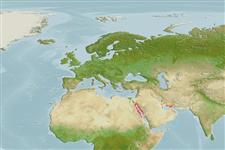Classification / Names
Common names | Synonyms | Catalog of Fishes(genus, species) | ITIS | CoL | WoRMS | Cloffa
Teleostei (teleosts) >
Kurtiformes (Nurseryfishes, cardinalfishes.) >
Apogonidae (Cardinalfishes) > Pseudamiinae
Etymology: Pseudamiops: Greek, pseudes = false + Greek, amia = a kind of shark + Greek, ops = appearance (Ref. 45335); springeri: Named for Dr Victor G. Springer, USNM, who collected the holotype.
Eponymy: Dr Victor Gruschka Springer (d: 1928) is an American ichthyologist. [...] (Ref. 128868), visit book page.
Environment: milieu / climate zone / depth range / distribution range
Ecology
Marine; reef-associated; depth range 5 - 18 m (Ref. 94042). Tropical
Western Indian Ocean: Red Sea, northern part of the Gulf of Aqaba and the Strait of Jubal,Egypt and north of Jeddah, Saudi Arabia.
Size / Weight / Age
Maturity: Lm ? range ? - ? cm
Max length : 2.7 cm SL male/unsexed; (Ref. 94042)
Short description
Identification keys | Morphology | Morphometrics
Dorsal spines (total): 7; Dorsal soft rays (total): 8; Anal spines: 2; Anal soft rays: 8; Vertebrae: 24. This species is distinguished by the following characters: D VI+I,8; A II,8; pectoral-fin rays 13; preopercle edge smooth or with 3-4 minute serrations ventrally; pseudobranch with 2-4 filaments; vomer without canine teeth; genital opening flanked by 2 slender papillae, one in front and one behind it; anterior nostril with skin flap, about twice nostril diameter, posteriorly on nostril’s rim, reaching at most half way to posterior nostril; no supraneural bones. Colour in life: body and head transparent, red gills, large peritoneal melanophores, series of eggs (opaque white, ovate objects), dark kidney and vertebral column clearly visible, grayish brown iris; after death, body of smaller paratype opaque white, gradually becoming translucent posteriorly and with small dusky spot behind eye on temporal area, gills partially visible through translucent opercle, large peritoneal melanophores clearly visible through abdominal body wall, black pupil black and silvery iris, but sometimes with irregular blackish markings and denser dorsally, clear fins; in alcohol, body cream white to yellowish dark brown; peritoneum with large stellate melanophores often visible through abdominal body wall; pale fins (Ref. 94042).
Similar to its congeners, this species is very cryptic, living deep inside caves. The smallest individual was collected about 2-3 m from the entrance of a cave on a seaward reef at 18 m deep, while others were found in caves at 5 and 11 m depth (Ref. 94042).
Life cycle and mating behavior
Maturity | Reproduction | Spawning | Eggs | Fecundity | Larvae
Gon, O., S.V. Bogorodsky and A.O. Mal, 2013. Description of a new species of the cardinalfish genus Pseudamiops (Perciformes, Apogonidae) from the Red Sea. Zootaxa 3701(1):093-100. (Ref. 94042)
IUCN Red List Status (Ref. 130435: Version 2024-1)
Threat to humans
Harmless
Human uses
Fisheries: of no interest
Tools
Special reports
Download XML
Internet sources
Estimates based on models
Preferred temperature (Ref.
123201): 25 - 28, mean 27.1 °C (based on 34 cells).
Phylogenetic diversity index (Ref.
82804): PD
50 = 0.5312 [Uniqueness, from 0.5 = low to 2.0 = high].
Bayesian length-weight: a=0.01000 (0.00244 - 0.04107), b=3.04 (2.81 - 3.27), in cm total length, based on all LWR estimates for this body shape (Ref.
93245).
Trophic level (Ref.
69278): 3.2 ±0.4 se; based on size and trophs of closest relatives
Resilience (Ref.
120179): High, minimum population doubling time less than 15 months (Preliminary K or Fecundity.).
Fishing Vulnerability (Ref.
59153): Low vulnerability (10 of 100).
